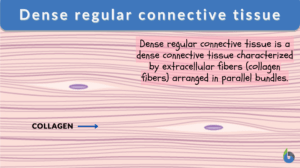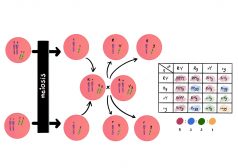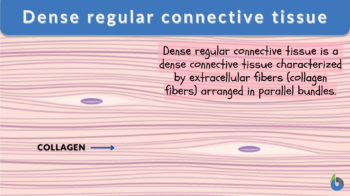
Dense regular connective tissue
n., plural: dense regular connective tissues
[dɛns ɹɛɡ.jə.lɚ kəˈnɛktɪv ˈtɪʃu]
Definition: dense connective tissue characterized by extracellular fibers that are arranged in a parallel fashion
Table of Contents
The dense connective tissue is a type of connective tissue proper that consists predominantly of fibers, especially type I collagen. The fibroblasts in the matrix generate these fibers. As the name implies, this type of connective tissue proper is dense or closely compacted in contrast to the other type, which is the loose connective tissue. Two forms of dense connective tissues include (1) dense regular connective tissue and (2) dense irregular connective tissue. Now, what is dense regular connective tissue? What makes it different from an irregular type of dense connective tissue? Let’s find out below.
Dense Regular Connective Tissue Definition
Dense regular connective tissues are connective tissues of a group or bundle of dense, robust, and large collagen fibers that hold the tissue and provide strength to it. Characteristically, in the dense regular tissue the collagen fibers are arranged loosely but in a parallel fashion. This connective tissue can be found in tendons (those that connect cartilage or bone to a muscle) and ligaments (those that connect two bones at the joint). The parallel arrangement of collagen fibers in dense regular connective tissue provides resilience to axially loaded tension forces. However, it permits stretching. Thus, these connective tissues are strong as well as flexible.
Connective tissue is one of the four main types of tissue found in the human body (others are epithelial, nervous, and muscular tissues). At this stage, it is important to understand connective tissue. As the name suggests, connective tissue functions to connect the different organs or tissues together in the body. Additionally, connective tissues hold or anchor the organ, separate one organ from the other and also encase the organs. In summary, it can be said that the connective tissue is the ‘glue’ that holds all the organs and parts of the body together and in their respective place.
Primarily, there are three types of connective tissues. They are (1) proper, (2) specialized, and (3) embryonic. The specialized connective tissue includes bone, cartilage, and adipose tissue. As for the embryonic connective tissues, they include mucous connective tissue and mesenchymal connective tissue.
Both dense and loose connective tissues are categorized under dense regular connective tissue proper. The primary differentiating point between dense and loose connective tissue is the presence of abundant ground substance relative to the fibers and other cells are few and thin.
Fat cells and fibroblasts are the primary cellular component of loose connective tissue. Also, loose connective tissue has a more gel-like viscous consistency (areolar tissue is an example of loose connective tissue). Conversely, the dense fibrous connective tissue is characterized by the presence of large, robust, and densely packed collagen fibrils or elastic fibers. The presence of a large amount of proteinous (collagen or elastic) fibers gives strength to this type of connective tissue.
The dense connective tissues can be further classified as the dense collagenous connective tissue and the dense elastic connective tissue. However, the collagenous connective tissue is more prevalent and is also known as the ‘white fibrous connective tissue’. The elastic fibers, in turn, are known as the ‘yellow fibrous connective tissue’. In the dense connective tissue fibroblast cells are organized between the rows of the fibers.
Fibroblast cells generate collagen fibers for the connective tissue. The dense connective tissues function not only to hold the organs together but to transmit the forces over a long distance. It is important to understand that the capacity of the dense connective tissue to resist the mechanical load depends upon the organization of the fibers in the tissue. The fibers in the dense connective tissue are either arranged in a parallel fashion (known as dense regular connective tissue) or the fibers are irregularly placed (known as dense irregular connective tissue).
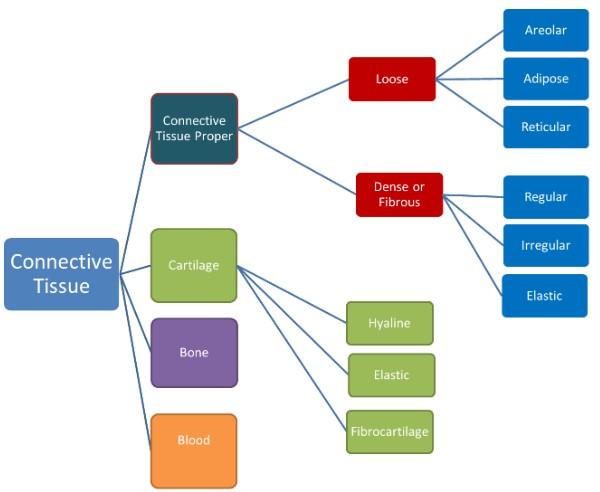
Watch this vid about dense regular connective tissue:
Know more about dense regular connective tissue. Join our Forum: Smooth muscle vs dense regular connective tissue. Be in touch with our community.
Dense regular connective tissue is a form of dense connective tissue characterized by the large, dense, and robust collagen fibers that are arranged in a parallel fashion. It makes it suitable for binding body parts together. It has great tensile strength resisting pulling forces, particularly from a single direction. Connective tissue in tendons and ligaments are examples of dense regular connective tissue. Other examples include the perichondrium around the tracheal cartilage and the tunica albuginea around the testis. The dense regular connective tissue occurs in two forms: white or yellow fibrous connective tissue.
Dense Regular Connective Tissue vs. Dense Irregular Connective Tissue
Now, let us briefly understand the difference between dense regular connective tissue and dense irregular connective tissue (Table 1)
Table 1: Differentiation between Dense regular connective tissue and Dense irregular connective tissue. | |
|---|---|
| Dense regular connective tissue | Dense irregular connective tissue |
| In dense regular connective tissue, the proteinaceous fibers (collagen/elastic) are arranged in a regular parallel fashion | In dense irregular connective tissue, the proteinaceous fibers (collagen/elastic) are arranged not arranged in a regular parallel fashion i.e., irregularly placed in the tissue |
| All the proteinaceous fiber bundles are arranged parallelly in a specific orientation or direction | All the proteinaceous fiber bundles are not arranged in any specific orientation or direction |
| The collagen fibers in the dense regular connective tissue acquire a dark staining | The collagen fibers in the dense irregular connective tissue do not acquire dark staining |
| The dense regular connective tissue can be stretched in a single direction only depending upon the orientation of the collagen fibers in it | The dense irregular connective tissue can be stretched in different directions as the fiber bundles are not aligned in any specific orientation |
| Dense regular connective tissue can also be multilayered where different bundles of collagen form multiple sheets in the tissue. Examples: Aponeurotic fasciae and Epimysial fasciae | Multilayered arrangement of proteinaceous fibers is not seen in dense irregular connective tissue |
| Ligaments and tendons have the dense regular connective tissue in it | Dermis in the skin has the dense irregular connective tissue |
Data Source: Dr. Amita Joshi of Biology Online
The image of dense regular connective tissue and dense irregular connective tissue under a microscope is shown in the figure below.
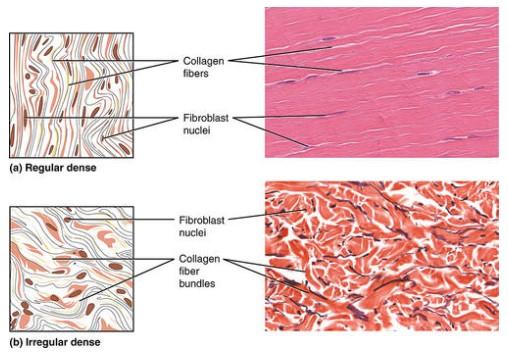
Interesting to Know!
Why does a ligament or tendon take so long to recover from an injury?
The reason for the prolonged recovery time for a ligament or tendon injury is that dense regular connective tissue in the ligament or tendon lacks blood vessels and hence poor blood supply resulting in slow healing of injuries.
Types of Dense Regular Connective Tissue
Based on the parallel arrangement of the collagen fibers, the dense regular connective tissue can be of two types:
- Collagen fibers parallel to each other- Can be seen in ligaments, tendons, and flat tendons or Aponeurosis
- Multilayered collagen fibers- Can be seen in Aponeurotic fasciae and Epimysial fasciae
Depending upon the predominant proteinaceous fibers, collagen or elastic, the dense regular connective tissue can be dense regular collagenous connective tissue or dense regular elastic connective tissue, respectively.
Structures Formed
The parallel arrangement of proteinous collagen fibers is typically seen in:
- The dense connective tissue connecting the two bones at the joint or the ligaments. Ligaments connect bones to bones. Interestingly, the ligaments are rich in elastic fibers.
- The dense connecting tissue is the tissue that connects muscle to bone or tendons. Characteristically, tendons have a very less number of elastic fibers. (Figure 3)
- Deep fasciae or the dense connective tissue that connects two muscles together are the multilayered structure of the dense regular connective tissue.
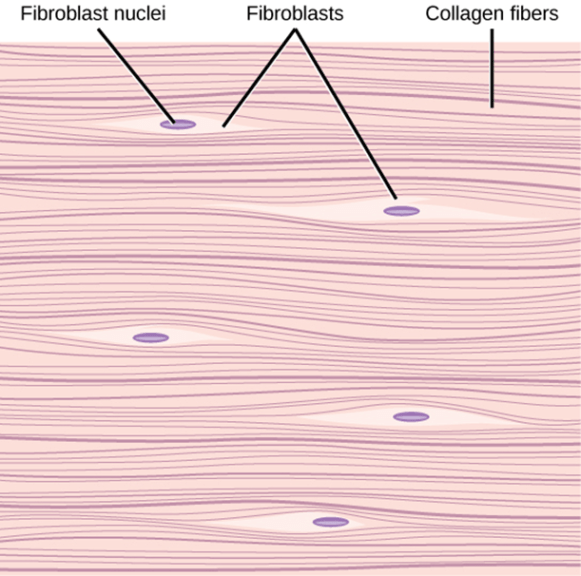
Dense Regular Connective Tissue Location
Where is dense regular connective tissue located?
The dense regular connective tissues can be found in the ligaments, tendons, and deep fasciae. Thus, dense regular connective tissue connects bones in joints and muscle to bone.
Dense Regular Connective Tissue Functions
The primary function of dense regular connective tissue includes:
- To connect different organs and muscles
- To transmit stress or forces over long distances. Dense regular connective tissues are highly resistant to the load however they do possess the required flexibility.
Thus based on the above discussion one can identify the primary functions of dense regular connective tissue.
Answer the quiz below to check what you have learned so far about dense regular connective tissue.
References
- Nassari, S., Duprez, D., & Fournier-Thibault, C. (2017). Non-myogenic Contribution to Muscle Development and Homeostasis: The Role of Connective Tissues. Frontiers in cell and developmental biology, 5, 22. https://doi.org/10.3389/fcell.2017.00022
- Cote, L. E., Simental, E., & Reddien, P. W. (2019). Muscle functions as a connective tissue and source of extracellular matrix in planarians. Nature communications, 10(1), 1592. https://doi.org/10.1038/s41467-019-09539-6
- Kamrani, P., Marston, G., & Jan, A. (2022). Anatomy, Connective Tissue. In StatPearls. StatPearls Publishing.
- Nezwek, T.A., Varacallo, M. (2021). Physiology, Connective Tissue. In: StatPearls [Internet]. Treasure Island (FL): StatPearls Publishing; 2022 Jan-. Available from: https://www.ncbi.nlm.nih.gov/books/NBK542226/
©BiologyOnline.com. Content provided and moderated by Biology Online Editors.

